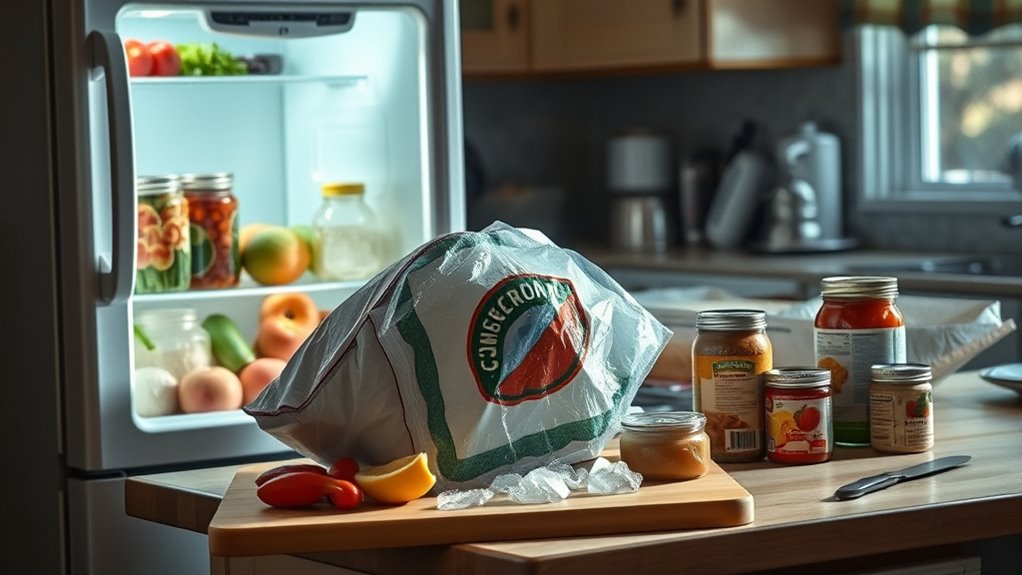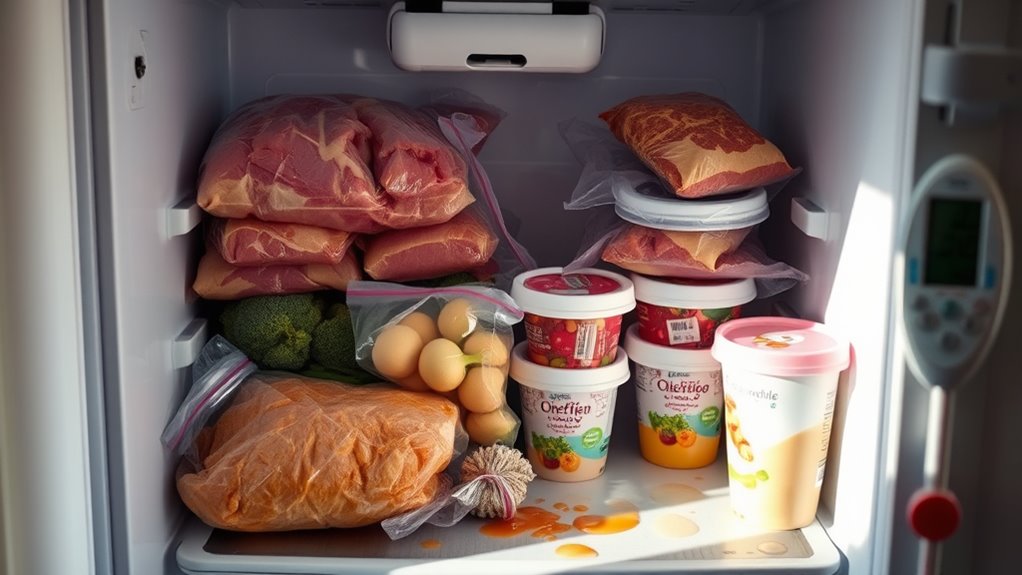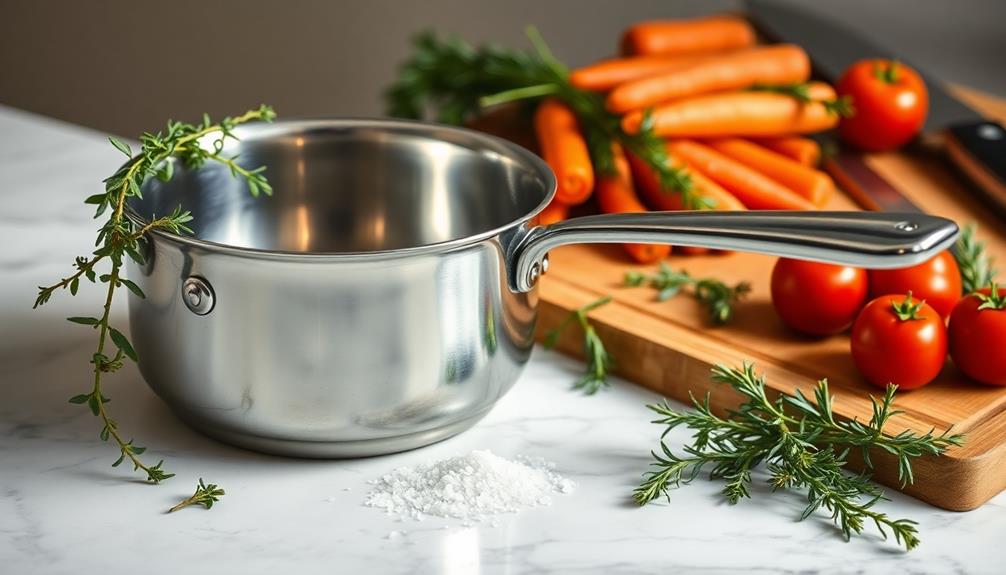During a power outage, prioritize keeping perishable foods safe by avoiding opening your fridge or freezer unless necessary. Toss any items in the fridge that have been above 40°F for over two hours and discard seafood, dairy, or cooked leftovers if they show signs of spoilage or warmth. Freeze-thawed foods that stay below 40°F and look okay can often be saved, but always use your thermometer and senses. To protect your health, learn key tips for managing food safety during outages.
Key Takeaways
- Discard perishable foods in the fridge if they remain above 40°F for over 2 hours.
- Keep freezer foods if still frozen and unopened; refreeze thawed items below 40°F if no spoilage signs.
- Avoid opening fridge or freezer doors unnecessarily to prevent temperature rise and spoilage.
- Toss foods with off smells, unusual textures, or that have been above safe temperatures for too long.
- Use thermometers to monitor food temperatures and follow safety guidelines to determine what to keep or discard.

Ever wondered how to keep your food safe during a power outage? The key is understanding the basics of food safety tips and being prepared in advance. When the power goes out unexpectedly, your refrigerator and freezer are your first line of defense against food spoilage. Knowing what to keep and what to toss can prevent foodborne illnesses and unnecessary waste. Emergency preparedness begins with organizing your fridge and freezer before an outage happens. Keep a thermometer in your fridge and freezer so you can monitor temperatures during the outage. A fridge should stay below 40°F (4°C), and a fully stocked freezer can keep food safe for about 48 hours if unopened. If the power outage is prolonged or you’re unsure how long it will last, plan accordingly. Have coolers and ice packs ready to transfer perishable foods if needed.
During the outage, avoid opening the fridge or freezer unless absolutely necessary. Each time you open the door, you let cold air escape, which accelerates spoilage. If you see that the power will be out for more than a few hours, consider transferring perishables to a cooler with ice packs. When it comes to food safety tips, concentrate on evaluating the temperature of your food once power is restored. Use a reliable food thermometer to check. If the food in your fridge is above 40°F for more than two hours, it’s safer to discard it. In the freezer, if food has thawed but remains cold (below 40°F) and shows no signs of spoilage, you might still be able to refreeze it. However, if it’s warm or has an off smell, it’s best to toss it.
It’s important to remember that not all food can be saved. Items like cooked leftovers, dairy products, and seafood are more susceptible to bacteria growth once temperature control is lost. When in doubt, follow the principle of “when in doubt, throw it out.” Proper emergency preparedness means keeping a list of non-perishable foods and supplies ready to go, so you aren’t caught unprepared. Stock up on canned goods, bottled water, and other shelf-stable items that won’t be affected by a power outage. This way, you can minimize the risk of consuming unsafe foods and ensure your family stays safe. Staying vigilant and prepared helps you navigate power outages confidently, protecting your health and reducing unnecessary food waste. Being aware of home appliance technology can help you better manage food storage during emergencies. Regularly checking your food storage temperatures ensures you can act quickly before food becomes unsafe. Additionally, understanding food safety guidelines allows you to make informed decisions about which foods to keep or discard.
Frequently Asked Questions
How Can I Tell if Frozen Food Is Still Safe?
You can tell if frozen food is still safe by checking the freezer temperature, which should stay at 0°F or lower. If the food has ice crystals and remains frozen, it’s likely safe. However, look for food discoloration or freezer burn, which can indicate spoilage. If the temperature rises or the food shows signs of thawing and refreezing, it’s best to toss it to avoid health risks.
What Should I Do if I Notice a Bad Smell?
If you notice a bad smell, trust your smell detection skills to identify spoiled food. Don’t ignore the odor; it’s a clear sign to discard the item. To guarantee safety, remove the source of the odor promptly and clean the area thoroughly to prevent lingering smells. Remember, if food smells off, it’s better to toss it than risk foodborne illness. Odor removal isn’t enough—discard questionable food immediately.
Can I Refreeze Food After a Power Outage?
Is refreezing food after a power outage a gamble or a safe move? According to refreezing guidelines, if the food has been above 40°F for more than two hours, it’s best to toss it. Food safety tips warn that refreezing can compromise quality and safety, especially with perishable items. When in doubt, prioritize safety over saving food, because the risk isn’t worth it.
How Long Can Cooked Food Stay Safely at Room Temperature?
You should never leave cooked food at room temperature safe for more than two hours, or one hour if it’s above 90°F. Bacteria grow quickly between 40°F and 140°F, so keeping cooked food beyond this duration risks foodborne illness. To guarantee safety, refrigerate or freeze cooked food promptly, and always discard anything that’s been out longer than the safe cooked food duration.
Are There Any Foods That Are Safe to Consume After Power Loss?
Many believe certain foods stay safe after a power outage, but food safety myths can be misleading. Typically, perishable foods like dairy, meat, and leftovers should be discarded if left out over two hours, especially in warm conditions. For emergency food planning, focus on non-perishable items like canned goods and dried foods. Trust guidelines from health authorities rather than assumptions, ensuring your safety and preventing foodborne illnesses.
Conclusion
Remember, a power outage is like a storm at sea—calm before the safety of solid ground. Trust your senses and guidelines to decide what stays and what goes. When in doubt, throw it out; it’s better to be safe than sorry. Keeping your food safe is like steering your ship clear of hidden icebergs—preventing trouble before it strikes. Stay vigilant, and you’ll navigate this challenge smoothly, protecting your health and peace of mind.










